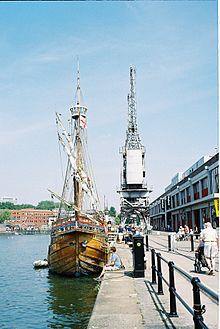M Shed
 |
|
|
Location within Bristol
|
|
| Established | 2011 |
|---|---|
| Location | Princes Wharf, Wapping Road, Bristol BS1 4RN, England, United Kingdom |
| Coordinates | 51°26′50″N 2°35′55″W / 51.4473°N 2.5986°W |
| Visitors | 711,530 (2013/14) |
| Website | M Shed |
M Shed is a museum in Bristol, England, located on Prince's Wharf beside the Floating Harbour in a dockside transit shed formerly occupied by Bristol Industrial Museum. The museum's name is derived from the way that the port identified each of its sheds. M Shed is home to displays of 3,000 Bristol artefacts and stories, showing Bristol's role in the slave trade and items on transport, people, and the arts. Admission is free.
The museum opened in June 2011, with exhibits exploring life and work in the city. In its first year, 700,000 people visited the new museum.
Normally moored in front of the museum is a collection of historic vessels, which include a 1934 fireboat (the Fire-float Pyronaut), and two tugboats ( Mayflower, the world's oldest surviving steam tug and John King, a 1935 diesel tug)
The museum contains a shop, learning space and cafe.
The standard opening hours are: Tuesday – Sunday, 10am–5pm. The museum is also open 10am-5pm on Bank Holiday Mondays and Mondays during Bristol school holidays.
On the quayside outside the museum are four electrically powered cargo cranes built in 1951 by Stothert & Pitt.Three of these cranes are operational and operate some weekends. A short distance to the west is a much older crane, the sole surviving operational example of a Fairbairn steam crane. Built in 1878, also by Stothert & Pitt, it was in regular use until 1973 loading and unloading ships and railway wagons with loads up to 35 tons. It has been restored and is in working order, operating on some bank holidays and the Bristol Harbour Festival.
The Bristol Industrial Museum closed in 2006 and was transformed into the M Shed. The conversion was designed by Lab Architecture Studio. It was expected to cost £27 million including a grant of £11.3 million from the Heritage Lottery Fund. Another £1.39 million of HLF funding was announced in April 2011. It reopened in June 2011. In its first year, 700,000 people visited the new museum.
...
Wikipedia

